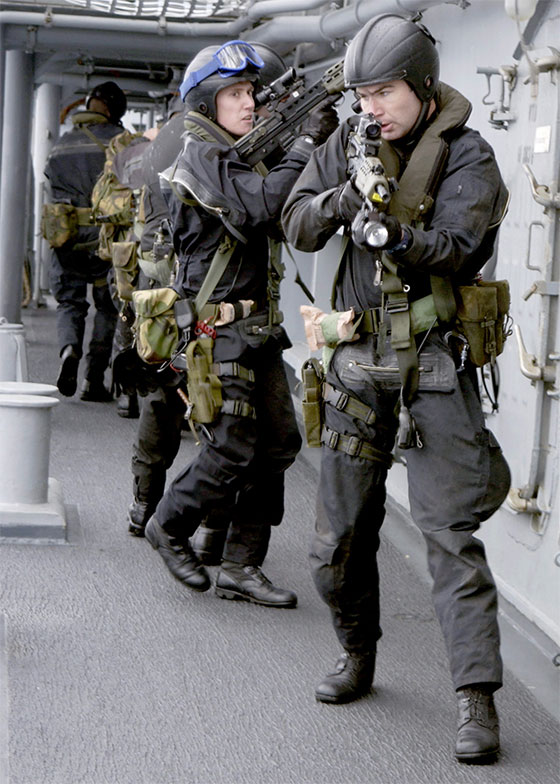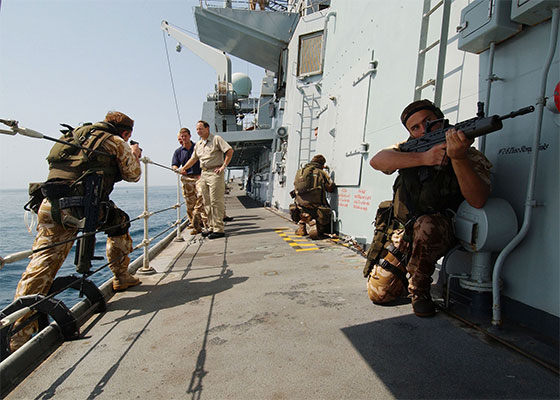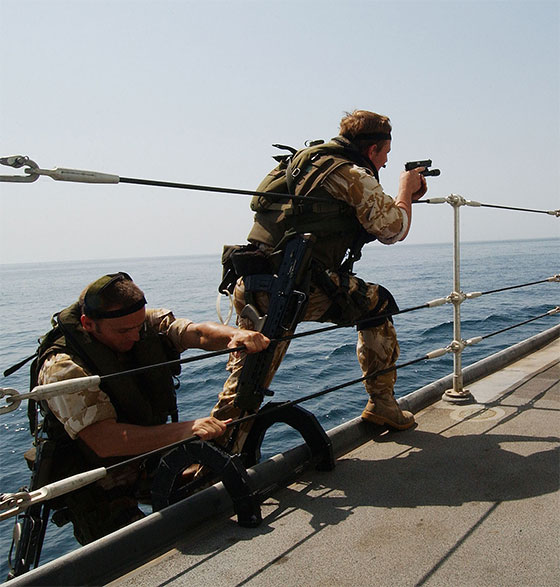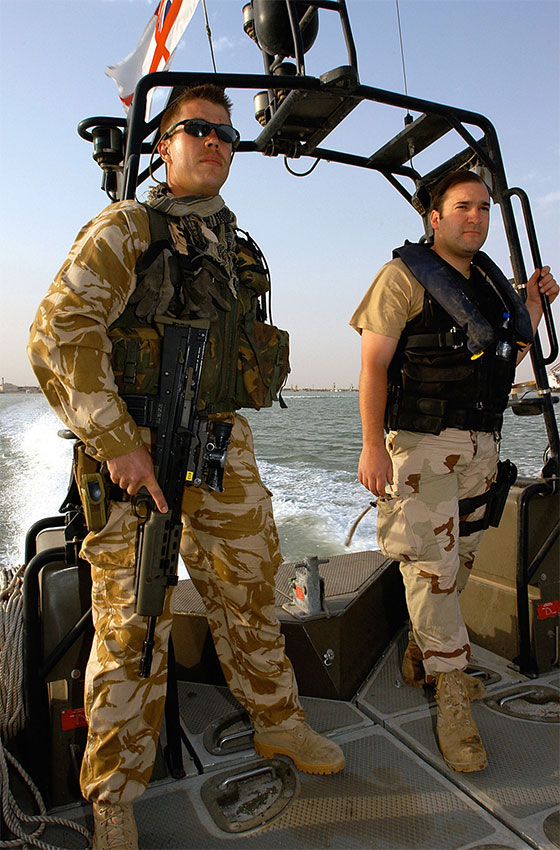Club "So British" - Les Royal Marines Commandos
4 participants
Page 1 sur 1
 Club "So British" - Les Royal Marines Commandos
Club "So British" - Les Royal Marines Commandos
ROYAL MARINES COMMANDO

La "Royal Marines" est la force d'infanterie de marine du Royaume-Uni. Elle dépend administrativement de la Royal Navy.
Ce corps des Royal Marines comprend deux grands commandements :
- - Training and Reserve Forces Royal Marines (responsables de la formation du personnel et des unités de réserve)
- 3 Commando Brigade Royal Marines (CBRM - composante opérationnelle du corps)
A ces 2 grands commandements, on peut également ajouter les unités indépendantes suivantes :
- Le 1 Assault Group Royal Marines (Landing Craft training)
- Le Fleet Protection Group Royal Marines (FPGRM - Seule unité opérationnelle RM hors du 3CBRM, anciennement Comacchio Group )
- Le Special Boat Service (SBS, Est-il nécessaire de les présenter ?)
La 3 Commando Brigade Royal Marines est, elle, composée des :
- 40 Commando Royal Marines (Bataillon de commandos-marines)
- 42 Commando Royal Marines (Bataillon de commandos-marines)
- 45 Commando Royal Marines (Bataillon de commandos-marines)
- Commando Logistic Regiment (Régiment de soutien logistique)
- 539 Assault Squadron Royal Marines (Escadron d'engins d'assaut amphibie)
- Commando Helicopter Force (Escadron d'hélicoptères Gazelle & AH-7 Lynx)
- UK Landing Force Command Support Group
Plusieurs unités de la British ou Territorial Army sont également rattachées à la 3 Commando Brigade Royal Marines :
- 1st Battalion "The Rifles" (Depuis Avril 2008)
- 29 Commando Regiment Royal Artillery (Régiment d'artillerie)
- 24 Commando Regiment Royal Engineers (composé des 59 & 131 Independent Commando Squadron Royal Engineers)
Les unités rattachées de la British Army sont également composées de membre "commando qualified"
"3 Commando Brigade" Tactical Recognition Flash (TRF) : 
"Royal Marines Commando" Shoulder Title Flash Rgt :

"Royal Marines Commando" Shoulder Title Flash Rgt :

Le UK Landing Force Command Support Group (UK LF CSG) qui est intégré dans la 3 Commando Brigade Royal Marines a pour objectifs l'information & la désinformation de l'ennemi. Ses missions sont variés et porte sur de l'espionnage, de la surveillance, l'acquisition des cibles et de la reconnaissance, etc.
Le CSG comprend :
- ¤ CSG Headquarters Troop
¤ Signals Squadron
¤ Brigade Staff Squadron
¤ Support Squadron
¤ Logistics Squadron, dont :
- - Brigade Patrol Troop
- Electronic Warfare Troop (Y Troop)
- Air Defence Troop
- Tactical Air Control Parties
- Police Troop
La Royal Marines Police Troop(RM PT) est la police militaire des British Royal Marines.
En temps de paix, elle assure la sécurité, l'application des lois & la prévention des crimes au sein de la Brigade.
Elle a sa propre section spéciale d'investigation le SIB - Special Investigation Branch (SIB) pour conduire les enquêtes en cas de crime ou d'infraction à la loi.
En temps de guerre, la Royal Marines Police Troop s'occupe de la sécurité des infrastructures, du contrôle du trafic et de l'approvisionnement, de l'escort des convois ainsi que toutes les missions habituellement accomplies en temps de paix.
La Royal Marines Police Troop s'occupe également de la protection des officiers et des personnes importantes.
Les Royal Marines Police Close Protection Teams (RMP CP) peuvent également être détachés auprès d'autres unités.
La Royal Marines Brigade Patrol Troop (BPT) est une unité spécialisée, à l'origine dans le combat en montagne et en zone arctique. Aujourd'hui, c'est une unité spécialisée dans la reconnaissance et le renseignement, composée d'équipes de 6 hommes.
Les Marines de la Brigade Patrol Troop sont comparables dans leur rôle et dans leurs compétences aux pelotons de Pathfinder chez les Paras. Techniquement ce ne sont pas des FS, mais ils sont considérés comme l'élite des commandos et c'est souvent une première marche pour une future entrée à la sélection des SBS.
En plus de l'entraînement classique des Royal Marines, les Marines des BPT sont aussi "Parachutist qualified".
Enfin, ce sont ces RMC là que l'on voit parfois utiliser des M16A2 / C7 Diemaco + M203, même si aujourd'hui ils sont revenus à l'utilisation du SA80a2.

Royal Marines Commando - Brigade Patrol Troop - Kosovo
Sources : royalnavy.mod, eliteukforces, wiki
Dernière édition par Belgandalfsan le Mer 6 Aoû 2008 - 10:50, édité 1 fois
 Re: Club "So British" - Les Royal Marines Commandos
Re: Club "So British" - Les Royal Marines Commandos
Royal Marines - FLEET PROTECTION GROUP
(FPG RM - Seule unité opérationnelle RM hors du 3CBRM, anciennement Comacchio Group)

Fleet Protection Group Royal Marines (FPGRM), pictured after boarding a US Navy destroyer during an exercise in 2003. Note the torches fixed to the SA80A2s to assist with searching unlit ship interiors. The FPG Marines are wearing Gecko protective helmets and have field-dressings attached to their webbing.

Fleet Protection Group Royal Marnes (FPGRM), taking part in a joint training exercise practise Vessel Boarding Search and Seizure (VBSS) drills on board US Navy destroyer USS O'Bannon.

A US Navy Officer observes ship boarding drills performed by Fleet Protection Group Royal Marines (FPGRM), operating from Royal Navy frigate, HMS Somerset. Note the use of iron sights rather than the 4x4 SUSAT optics usually fitted to the Marine's SA80A2 rifles. These sghts are better for the close quarters environment of a ship.

Fleet Protection Group Royal Marines (FPGRM) boarding HMS Somerset during a training exercise. Note the Royal Marine armed with a Browning High Power pistol, his SA80A2 slung at his side - often a necessity when clambering aboard a vessel.

A Royal Marine from O rifle squadron, Fleet Protection Group, takes aim with his Browning High Power 9mm pistol whilst training aboard HMS Portland, a Royal Navy frigate. Note the cord attached to the pistol, ensuring that the weapon cannot be lost.

A Royal Marine from the Fleet Protection Group (FPG) pictured next to a member of the US Coast Guard, taking part in a riverine patrol around the Southern Iraq port of Umm Qasr in 2004. Royal Marines boat teams from both the FPG and 539 Assault Squadron have taken turns in patrolling the waterways around Umm Qasr and Basra.

Fleet Protection Group (FPG) Royal Marines move along the deck of a small ship during training in the Indian Ocean. As their role demands, the Marines are wearing Gecko Marine Safety helmets and life jackets.
(FPG RM - Seule unité opérationnelle RM hors du 3CBRM, anciennement Comacchio Group)

Fleet Protection Group Royal Marines (FPGRM), pictured after boarding a US Navy destroyer during an exercise in 2003. Note the torches fixed to the SA80A2s to assist with searching unlit ship interiors. The FPG Marines are wearing Gecko protective helmets and have field-dressings attached to their webbing.

Fleet Protection Group Royal Marnes (FPGRM), taking part in a joint training exercise practise Vessel Boarding Search and Seizure (VBSS) drills on board US Navy destroyer USS O'Bannon.

A US Navy Officer observes ship boarding drills performed by Fleet Protection Group Royal Marines (FPGRM), operating from Royal Navy frigate, HMS Somerset. Note the use of iron sights rather than the 4x4 SUSAT optics usually fitted to the Marine's SA80A2 rifles. These sghts are better for the close quarters environment of a ship.

Fleet Protection Group Royal Marines (FPGRM) boarding HMS Somerset during a training exercise. Note the Royal Marine armed with a Browning High Power pistol, his SA80A2 slung at his side - often a necessity when clambering aboard a vessel.

A Royal Marine from O rifle squadron, Fleet Protection Group, takes aim with his Browning High Power 9mm pistol whilst training aboard HMS Portland, a Royal Navy frigate. Note the cord attached to the pistol, ensuring that the weapon cannot be lost.

A Royal Marine from the Fleet Protection Group (FPG) pictured next to a member of the US Coast Guard, taking part in a riverine patrol around the Southern Iraq port of Umm Qasr in 2004. Royal Marines boat teams from both the FPG and 539 Assault Squadron have taken turns in patrolling the waterways around Umm Qasr and Basra.

Fleet Protection Group (FPG) Royal Marines move along the deck of a small ship during training in the Indian Ocean. As their role demands, the Marines are wearing Gecko Marine Safety helmets and life jackets.
Dernière édition par Belgandalfsan le Mer 6 Aoû 2008 - 10:49, édité 3 fois
 Re: Club "So British" - Les Royal Marines Commandos
Re: Club "So British" - Les Royal Marines Commandos
Niveau matos,ils sont un peu... Light, non ?
'Fin je trouve que ça leur file plus un coté Pirate que Défenseur de la bannière Divisée.
'Fin je trouve que ça leur file plus un coté Pirate que Défenseur de la bannière Divisée.

jericho- Yack Hibernant

- Nombre de messages : 4602
Age : 35
Localisation : Au fond du trou.
Date d'inscription : 13/05/2008
 Re: Club "So British" - Les Royal Marines Commandos
Re: Club "So British" - Les Royal Marines Commandos
avec leurs casques on dirait des tritons ^^
pour jericho : a mon avis si yen a un qui tombe a l'eau avec tout son matos :/ c pour ca que c light, surtout que c que du cqb
pour jericho : a mon avis si yen a un qui tombe a l'eau avec tout son matos :/ c pour ca que c light, surtout que c que du cqb
 Re: Club "So British" - Les Royal Marines Commandos
Re: Club "So British" - Les Royal Marines Commandos
Le casque est vraiment atroce... en tout cas avec peut de moyen ça permetrais de faire une variante de gear 
 Re: Club "So British" - Les Royal Marines Commandos
Re: Club "So British" - Les Royal Marines Commandos
Entrainement à l'abordage/reprise d'un navire : ça c'est pour le côté Pirate.Jericho a écrit:'Fin je trouve que ça leur file plus un coté Pirate que Défenseur de la bannière Divisée.
Maintenant si tu regardes les pirates actuels, ça ressemble pas du tout à ça. C'est plus du "rebel" africain/asiatique avec un Ak.
+1 avec JE (Chute en mer + CQB dans les coursives)Vrinsk a écrit:pour jericho : a mon avis si yen a un qui tombe a l'eau avec tout son matos :/ c pour ca que c light, surtout que c que du cqb
Maintenant si tu regardes bien, ils ont juste ce qu'il faut pour une force d'intervention en milieu confiné, déposée sur place et qui n'y restera pas longtemps : Fusil d'assault (L85A2), Pistolet Auto (Browning High Power pistol) et mun. correspondante (6 x mag. de L85), lampes tactiques, gilet de sauvetage, ...
C'est d'ailleurs intéressant de voir à quel point leur équipement est diff. et adapté à leurs missions.
Pour le casque, c'est des "Gecko Marine Safety helmet" je suis pas non plus fan... mais bon, les gouts et les couleurs.
[J'ai édité mon précédent post pr ajout de photos supp. & commentaires]
 Re: Club "So British" - Les Royal Marines Commandos
Re: Club "So British" - Les Royal Marines Commandos
Ca pourrait être très mignon avec un casque Kevlar ASMC (Qui ressemble aux casques des troupes d'intervention jÔr GIGN, mais sans la visière.)

jericho- Yack Hibernant

- Nombre de messages : 4602
Age : 35
Localisation : Au fond du trou.
Date d'inscription : 13/05/2008
 Re: Club "So British" - Les Royal Marines Commandos
Re: Club "So British" - Les Royal Marines Commandos
Royal Marines Commandos - MOUNTAIN LEADERS
MOUNTAIN LEADERS
Mountain Leaders are an elite cadre of Royal Marines who are experts in long range reconnaissance, arctic warfare and mountain climbing. As the The Mountain Leader Training Cadre (MLTC), their primary peacetime role is to teach their techniques to other Commando Troops and share their expertise with other military units. During wartime, the Mountain Leaders are able to provide an additional recce capability for 3 Commando Brigade, integrating with the Brigade Reconnaissance Force (BRF) Brigade Patrol Troop to form the Brigade Patrol Group.
Mountain Leaders are not strictly-speaking Special Forces, even though their standards of selection and training are considered by some to be as hard, if not harder, than UKSF units. Mountain Leaders are under the control of 3 Commando Brigade, not UKSF.
MOUNTAIN LEADERS HISTORY
The unit's history can be traced back to the Cliff Assault Wing formed in the 1950s, later to become the Cliff Assault Troop. These 'Cliff Leaders' were tasked with leading the Commando units up cliffs and operating in arctic conditions. The appropriate skills and techniques were developed and perfected and then passed on the rest of the Royal Marines. The Cliff Assault Troop was renamed to the Reconnaissance Leader Troop in 1965 until 1970 when it was renamed again to the Mountain & Arctic Warfare Cadre. The M&AWC helped prepare 3 Commando Brigade for its cold war role, protecting NATO's northern flank. Were war to break out, the M&AWC would provide long range arctic reconnaissance to 3 CDO BDE, operating on foot and on skis.
The Falklands
When Argentina invaded the Falklands in 1982, the M&AWC reconfigured from training to a war footing, raising patrols for 3 Commando Brigade. Following the main amphibious landings on May 21st, 4-man patrols were inserted onto the islands where they carried out recce missions, augmenting the SAS and SBS patrols already operating. Their war was not limited to reconnaissance, however. 10 days after the main landings, the M&AWC engaged in a fierce firefight with Argentine Special Forces at Top Malo House.
The 90s onwards
The Brigade Reconnaissance Force (BRF) was raised in the early nineties to fill the need of a permanent medium recce force for 3 Cdo Bde. Mountain Leader NCOs were used to command these patrols, which eventually became known as the Brigade Patrol Troop. Other MLs remained in the training role, in the form of The Mountain Leader Training Cadre (MLTC).
MOUNTAIN LEADER TRAINING
The Mountain Leaders course is one of the hardest in the British military, as indicated by its 20% pass rate. To gain the Mountain Leaders (ML2) specialty, a Royal Marine must go through an eight-month training course, starting with a week-long selection. An extensive and challenging training regime follows which features:
Once qualified, a Mountain Leader (ML2) will usually be integrated into the Commandos, often into the Reconnaissance Troops of the Command Company (40, 42 or 45 Commando).
1 -
2 -
3 -
4 -
5 -
6 -
7 -
8 -
MOUNTAIN LEADERS
Mountain Leaders are an elite cadre of Royal Marines who are experts in long range reconnaissance, arctic warfare and mountain climbing. As the The Mountain Leader Training Cadre (MLTC), their primary peacetime role is to teach their techniques to other Commando Troops and share their expertise with other military units. During wartime, the Mountain Leaders are able to provide an additional recce capability for 3 Commando Brigade, integrating with the Brigade Reconnaissance Force (BRF) Brigade Patrol Troop to form the Brigade Patrol Group.
Mountain Leaders are not strictly-speaking Special Forces, even though their standards of selection and training are considered by some to be as hard, if not harder, than UKSF units. Mountain Leaders are under the control of 3 Commando Brigade, not UKSF.
MOUNTAIN LEADERS HISTORY
The unit's history can be traced back to the Cliff Assault Wing formed in the 1950s, later to become the Cliff Assault Troop. These 'Cliff Leaders' were tasked with leading the Commando units up cliffs and operating in arctic conditions. The appropriate skills and techniques were developed and perfected and then passed on the rest of the Royal Marines. The Cliff Assault Troop was renamed to the Reconnaissance Leader Troop in 1965 until 1970 when it was renamed again to the Mountain & Arctic Warfare Cadre. The M&AWC helped prepare 3 Commando Brigade for its cold war role, protecting NATO's northern flank. Were war to break out, the M&AWC would provide long range arctic reconnaissance to 3 CDO BDE, operating on foot and on skis.
The Falklands
When Argentina invaded the Falklands in 1982, the M&AWC reconfigured from training to a war footing, raising patrols for 3 Commando Brigade. Following the main amphibious landings on May 21st, 4-man patrols were inserted onto the islands where they carried out recce missions, augmenting the SAS and SBS patrols already operating. Their war was not limited to reconnaissance, however. 10 days after the main landings, the M&AWC engaged in a fierce firefight with Argentine Special Forces at Top Malo House.
The 90s onwards
The Brigade Reconnaissance Force (BRF) was raised in the early nineties to fill the need of a permanent medium recce force for 3 Cdo Bde. Mountain Leader NCOs were used to command these patrols, which eventually became known as the Brigade Patrol Troop. Other MLs remained in the training role, in the form of The Mountain Leader Training Cadre (MLTC).
MOUNTAIN LEADER TRAINING
The Mountain Leaders course is one of the hardest in the British military, as indicated by its 20% pass rate. To gain the Mountain Leaders (ML2) specialty, a Royal Marine must go through an eight-month training course, starting with a week-long selection. An extensive and challenging training regime follows which features:
- climbing cliffs
- free climbing (without ropes)
- mountaineering
- survival
- resistance to interrogation (RTI) training
- ice climbing
- arctic survival
- arctic navigation
- long distance skiing
Once qualified, a Mountain Leader (ML2) will usually be integrated into the Commandos, often into the Reconnaissance Troops of the Command Company (40, 42 or 45 Commando).
1 -
2 -
3 -
4 -
5 -
6 -
7 -
8 -
 Sujets similaires
Sujets similaires» Club "So British" - KIT LIST - Tenue Desert
» Club "So British" - Matos - SA80 Bayonet
» Club "So British" - Matos - SA80 Rifle (L85)
» Club "So British" - Matos - Les badges
» Club "So British" - PHOTOS
» Club "So British" - Matos - SA80 Bayonet
» Club "So British" - Matos - SA80 Rifle (L85)
» Club "So British" - Matos - Les badges
» Club "So British" - PHOTOS
Page 1 sur 1
Permission de ce forum:
Vous ne pouvez pas répondre aux sujets dans ce forum
